Everything You Need To Know About White Marble Flooring With Amazing Design Ideas
White marble flooring has become synonymous with elegance and luxury. Its timeless beauty and versatility make it a popular choice for a variety of spaces. Whether you’re updating your home or outfitting a commercial area, white marble offers a sophisticated look that can elevate any room.
In this article, we’ll explore the advantages and disadvantages of white marble flooring, its various applications, and provide design ideas and alternatives to help you make the best choice for your space.

Advantages of White Marble Flooring
Aesthetic Appeal
White marble flooring is celebrated for its timeless elegance and sophisticated look. Its natural veining and subtle color variations contribute to a luxurious ambiance, ideal for both homes and businesses.
The reflective quality of white marble enhances natural light, brightening rooms and creating a sense of spaciousness. This classic appeal makes white marble a sought-after choice for those aiming to add a touch of refinement and openness to their spaces.
Versatility in Design
White marble floor tiles are highly versatile, making them suitable for various interior styles. Their adaptability ranges from contemporary to traditional aesthetics. White marble epoxy flooring delivers a sleek, glossy finish ideal for modern spaces.
While honed marble offers a matte surface that complements traditional or rustic decor. This versatility allows white marble to seamlessly integrate into different design themes, enhancing both modern and classic interiors.
Durability
White marble flooring is highly durable and long-lasting when properly maintained. Its natural strength and density make it capable of withstanding heavy foot traffic, making it ideal for high-traffic areas.
The stone’s resilience is a result of its dense composition, which helps it endure everyday use without significant wear. Regular care, such as cleaning and sealing, further enhances its longevity, ensuring that it remains a beautiful and functional choice for years.
Value Addition
Installing white marble floors can significantly boost your home’s value. Their elegant, high-end look and robust durability make them highly appealing to potential buyers. This luxurious feature not only enhances the aesthetic appeal of your space.
But also provides a practical benefit with its long-lasting quality. As a result, white marble floors can be a strong selling point if you decide to put your property on the market, offering a potential advantage in achieving a higher resale value.
Disadvantages of White Marble Flooring
Maintenance Requirements
White marble floors need consistent upkeep to maintain their beauty. They are susceptible to staining and scratching, which can be difficult to handle. To keep them looking pristine, clean the floors regularly using a pH-neutral cleaner. Periodic sealing is essential to protect the marble from stains and damage.
Immediate attention to spills and proper cleaning techniques can help prevent discoloration and extend the life of the flooring. Regular maintenance is crucial for preserving the elegance and durability of white marble floors.
Cost
White marble flooring typically comes with a higher price tag compared to other flooring materials. The initial cost includes not just the marble itself but also installation and ongoing maintenance expenses, which can add up significantly. This makes it a crucial factor to consider if you’re managing a tight budget.
While white marble adds a luxurious and elegant touch to any space, its cost may be prohibitive for some, requiring careful financial planning and consideration of alternative flooring options.
Susceptibility to Damage
Marble is a natural stone that is particularly vulnerable to damage from acidic substances. Spills of lemon juice, vinegar, or acidic cleaners can cause etching, which leads to discoloration and surface damage. This occurs because acids react with the calcium carbonate in marble, weakening its surface.
To prevent long-term damage, it’s crucial to promptly clean up spills and use pH-neutral cleaners. Regular sealing can also help protect marble surfaces from acidity and maintain their appearance.
Slipperiness
White marble flooring is popular in residential spaces like living rooms, bathrooms, and entryways for its elegant and sophisticated look. It serves as a stunning focal point, enhancing the room’s aesthetic.
Combining white marble with black accents can create a striking contrast, adding sophistication and a classic touch to the design. This versatile material not only elevates the overall appearance of a space but also offers a timeless appeal, making it a favored choice for stylish, upscale interiors.
White marble flooring Design Ideas
White marble flooring offers a range of design possibilities to suit various tastes and styles. Here are a few ideas:
Marble Floor Design With Diamond Motif
Incorporating diamond motifs into white marble flooring can elevate the space with a luxurious touch. This design choice adds a classic elegance and sophisticated flair to any room. The diamond pattern, achieved through precise cutting and placement, enhances the natural beauty of the marble, creating a visually striking effect.
Whether used as a central feature or a border, the diamond motif makes the floor a standout element in your home. This refined design not only highlights the marble’s inherent qualities but also contributes to a high-end, polished aesthetic, perfect for adding a touch of opulence to your interior.

Marble Flooring With Borders
Marble flooring with borders enhances both aesthetics and spatial definition. By adding a border around your marble floor, you create a clear delineation that can accentuate the design. Opt for contrasting colors or patterns for the border to make it stand out and draw attention.
This technique not only highlights the elegance of the marble but also introduces a touch of sophistication and visual interest to the space. Whether you choose a subtle or bold border, it can transform your flooring into a distinctive feature that enhances the overall look of your room.

Straight Lay Marble Tiles
Straight lay marble tiles offer a timeless and elegant look for flooring. This design aligns tiles in a uniform, grid-like pattern, creating a clean and uninterrupted surface. By placing each tile in a straight, parallel arrangement, the natural veining and unique patterns of the marble are prominently displayed without distraction.
This classic approach not only emphasizes the marble’s beauty but also enhances the overall sophistication of a space, making it a popular choice for both traditional and modern interiors. The result is a seamless and polished appearance that highlights the marble’s natural elegance.

Classic Marble Flooring
Classic white marble flooring offers a timeless and elegant look that enhances any space. Its crisp, clean appearance works seamlessly in both traditional and contemporary interiors, providing a versatile foundation for various design styles. The natural veining in the marble adds sophistication and uniqueness, making each floor an individual masterpiece.
Durable and easy to maintain, classic white marble is a practical choice that doesn’t compromise on style. Whether you’re aiming for a refined traditional ambiance or a sleek modern vibe, this flooring option provides a lasting, luxurious touch to your home.
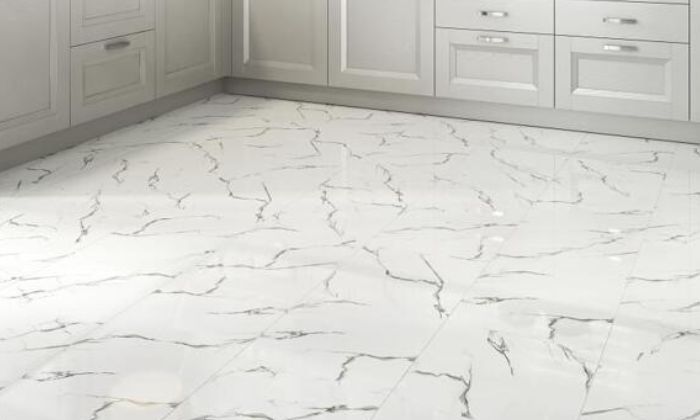
A Mix of Patterns
Combining various patterns and tile sizes in your flooring design creates a distinctive and personalized look. By mixing different styles—like geometric, floral, or mosaic patterns—you add depth and visual intrigue to the space. Varying tile sizes can enhance this effect, allowing you to craft a custom aesthetic that reflects your individual taste.
This method not only brings character to your floors but also allows for creative expression and can make your space stand out. Whether in a small room or a large area, a mix of patterns and sizes makes your flooring a focal point of your decor.
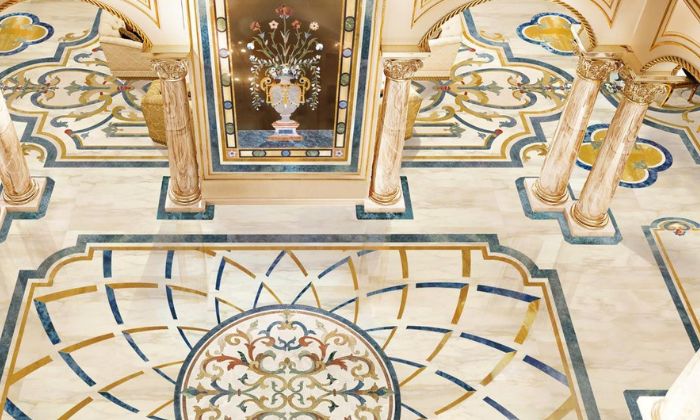
Striped Marble Floor Tiles
Striped marble floor tiles feature alternating bands of various shades or colors, creating a striking and contemporary appearance. The use of stripes introduces a bold visual element, transforming a standard floor into a dynamic and eye-catching feature.
By incorporating these tiles, you can add a modern flair to your space, enhancing its aesthetic appeal with a sophisticated pattern that stands out. Whether opting for subtle tones or vibrant contrasts, striped marble tiles offer a versatile design choice that can invigorate any room with a fresh, stylish look.
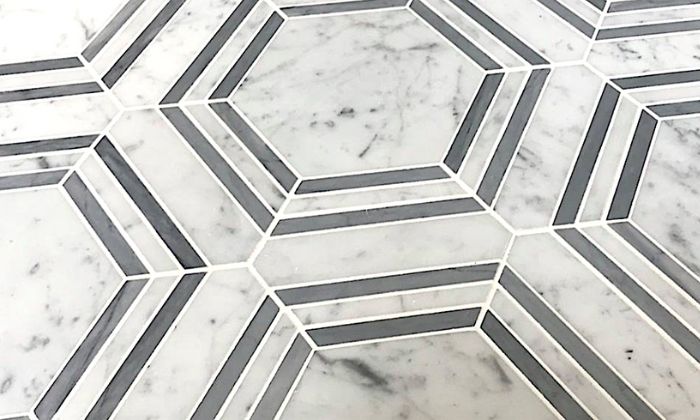
Color Coordinated
To achieve a cohesive and stylish look, ensure your marble flooring complements other room elements. Match the marble’s color and pattern with your wall colors and furnishings to create harmony. For example, if your marble has warm tones, choose wall colors and furniture in complementary hues.
This coordination enhances the overall aesthetic and makes the space feel well-designed and integrated. By paying attention to color harmony between the marble and other room elements, you create a unified and appealing environment that feels thoughtfully curated.
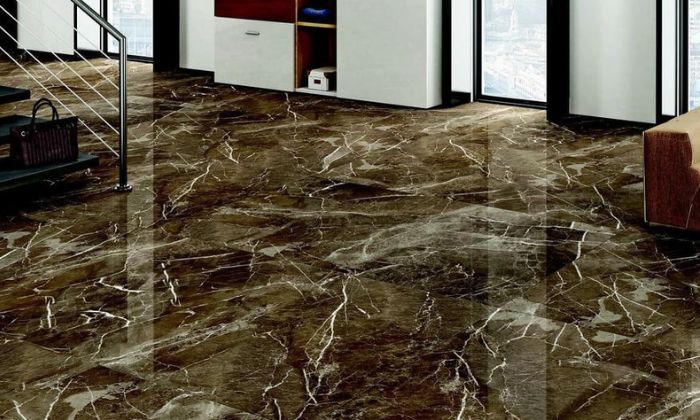
Marble Flooring That Looks Like A Zebra Crossing
Create a bold, eye-catching look with marble flooring that mimics a zebra crossing. By alternating contrasting black and white marble tiles, you can achieve a dynamic zebra stripe pattern. This playful design not only adds visual interest but also makes a unique statement in any room.
The high-contrast colors of the marble tiles enhance the pattern’s impact, offering a modern and stylish touch to your flooring. Ideal for spaces looking to make a distinctive impression, this design approach combines elegance with a touch of fun.
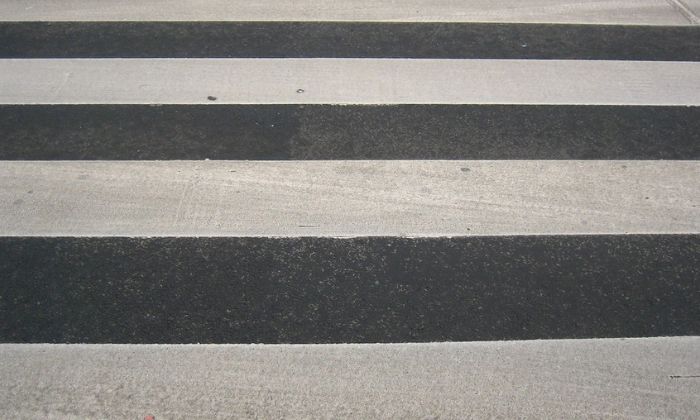
Black Nebula
Black Nebula marble is an elegant choice for creating a striking contrast with white marble, adding depth and sophistication to any space. Its rich, dark tones and unique veining patterns provide a dramatic focal point that enhances the overall design.
Incorporating Black Nebula marble into your flooring can transform a room by introducing a sense of luxury and modernity. The interplay between the dark marble and lighter elements in the room creates a visually dynamic and sophisticated effect, making it an excellent choice for high-impact design.
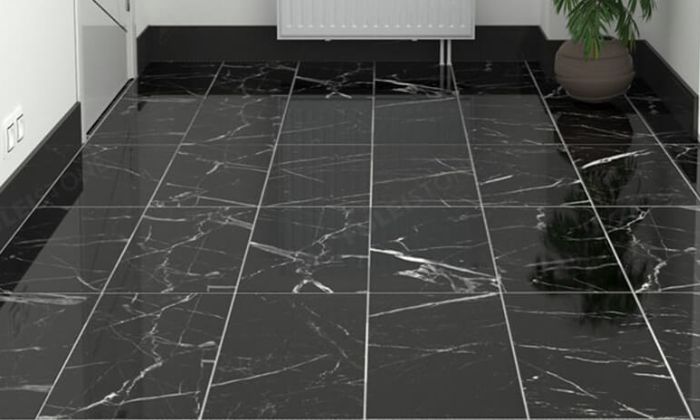
A Border Pattern
A border pattern around your white marble flooring creates a striking visual frame that accentuates the elegance of the marble. By outlining the edges with a contrasting or complementary material, you add definition and structure to the space.
This design technique not only highlights the marble’s natural beauty but also enhances the room’s overall aesthetic, making it appear more refined and cohesive. The border pattern acts as a decorative boundary, drawing attention to the flooring while seamlessly integrating it into the room’s design.

Applications of White Marble Flooring
Residential Use
In residential spaces, white marble flooring is popular for its elegant and timeless look, enhancing areas like living rooms, bathrooms, and entryways. Its sophisticated appearance serves as a striking focal point, adding a touch of luxury.
Combining white marble with black marble can create a dramatic contrast, elevating the room’s style and adding sophistication. This classic pairing highlights the beauty of white marble while introducing a modern edge to traditional decor.
Commercial Use
White marble is widely used in commercial spaces like hotels, retail stores, and offices due to its durability and elegant appearance. Its strength makes it suitable for high-traffic areas, while its classic beauty adds a touch of luxury and sophistication.
Installing white marble floor tiles in lobbies or reception areas enhances the space with a welcoming and upscale ambiance, making it a favored choice for creating impressive and enduring first impressions.
Maintenance and Care
Regular Cleaning
To keep white marble floors looking pristine, regular cleaning is crucial. Use a pH-balanced cleaner and avoid harsh chemicals, which can harm the marble’s surface. Consistent sweeping or vacuuming helps remove dirt and debris, preventing scratches. This routine maintenance preserves the marble’s natural luster and prevents long-term damage.
How to Deal with Stains and Spills
To manage stains and spills, act quickly by blotting spills with a soft cloth to prevent them from setting. For persistent stains, create a paste using baking soda and water, then gently scrub the affected area with a soft cloth.
Avoid abrasive scrubbers, as they can damage the surface. Prompt cleaning and gentle treatment will help maintain the appearance of your surfaces and prevent long-term damage.
Sealing and Protecting White Marble
To safeguard white marble, regular sealing is essential. Apply a marble-specific sealant every 6 to 12 months, based on the level of use and exposure. This routine helps prevent stains and damage, preserving the marble’s appearance and durability.
The sealant creates a protective barrier that maintains the marble’s finish and extends its lifespan. Regular application is key to keeping white marble looking pristine and ensuring it remains a beautiful feature in your home.
Avoiding Common Mistakes
To maintain marble surfaces, avoid acidic or abrasive cleaners, as they can damage the stone. Minimize moisture exposure to prevent deterioration and discoloration. In high-traffic areas, use rugs or mats to protect the marble from scratches and stains. These precautions will help preserve the beauty and integrity of your marble surfaces.
Alternatives to White Marble Flooring
If you’re considering alternatives to white marble flooring, here are some options:
Porcelain Tiles
Porcelain tiles are a cost-effective alternative to white marble, offering a similar luxurious look. Made from refined clay and fired at high temperatures, these tiles can replicate the elegant appearance of marble while being more budget-friendly. They are also easier to maintain, as they resist stains, scratches, and moisture better than natural marble.
This durability and low upkeep make porcelain tiles an attractive choice for those seeking the aesthetic appeal of marble without the high cost and maintenance challenges.
Quartz
Engineered quartz mimics the elegant appearance of marble but provides superior durability and lower maintenance. Unlike natural marble, which is porous and prone to staining and scratching, quartz surfaces are made from a blend of natural quartz crystals and resins.
This combination creates a non-porous, highly resilient material that resists stains, scratches, and heat. Additionally, engineered quartz requires minimal upkeep, as it does not need sealing and is easy to clean. This makes it an ideal choice for high-traffic areas and busy households looking for both style and practicality.
Vinyl Flooring
High-quality vinyl flooring can effectively mimic the appearance of marble, offering a stylish and affordable alternative to genuine marble. This option is ideal for those on a budget who want the elegance of marble without the high cost. Vinyl flooring is available in various designs and finishes that closely resemble marble’s texture and appearance.
Making it a popular choice for homeowners seeking both aesthetics and practicality. Its durability and ease of maintenance further enhance its appeal, making it a practical solution for achieving a sophisticated look without breaking the bank.
Conclusion
White marble flooring offers a blend of elegance and durability that can transform any space. Whether you choose it for its aesthetic appeal or its value addition to your home, understanding its advantages and disadvantages will help you make an informed decision.
With proper maintenance, white marble can remain a stunning feature in your home for years to come. Explore the various design ideas and alternatives to find the perfect fit for your style and needs. Transform your space with our expert services contact us if you have any query or want to take our services.
